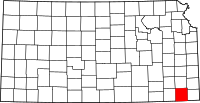Labette County, Kansas
| Labette County, Kansas | |
|---|---|
| County | |

Big Hill Lake in western Labette County
|
|
 Location in the U.S. state of Kansas |
|
 Kansas's location in the U.S. |
|
| Founded | February 26, 1867 |
| Named for | Pierre La Bette |
| Seat | Oswego |
| Largest city | Parsons |
| Area | |
| • Total | 653 sq mi (1,691 km2) |
| • Land | 645 sq mi (1,671 km2) |
| • Water | 7.8 sq mi (20 km2), 1.2% |
| Population | |
| • (2010) | 21,607 |
| • Density | 33/sq mi (13/km²) |
| Congressional district | 2nd |
| Time zone | Central: UTC-6/-5 |
| Website | LabetteCounty |
Coordinates: 37°12′N 95°17′W / 37.200°N 95.283°W
Labette County (county code LB) is a county located in the U.S. state of Kansas. As of the 2010 census, the county population was 21,607. Its county seat is Oswego, and its most populous city is Parsons. The county was named after LaBette creek, the 2nd largest creek in the county, which runs roughly NNW-SSE from near Parsons to Chetopa. The creek in turn was named after French-Canadian fur trapper Pierre LaBette who had moved to the area, living along the Neosho River, and marrying into the Osage tribe in the 1830s and 1840s.
In the 1840s Labette County had a population mainly consisting of Osage people, although there were also many Cherokee and Euro-Americans. Many of the Euro-Americans were merchants with Osage or Cherokee wives.
Between 1871 and 1873, at least eleven people vanished in the vicinity of an inn and general store operated by the Bender family in Labette County. Following the disappareance of the Benders in 1873, it was discovered that they had apparently murdered a number of travellers. Between eight and eleven bodies were discovered buried on the premises. Governor Thomas A. Osborn offered a reward of $2,000 for the apprehension of the Benders, but they were never found.
...
Wikipedia
